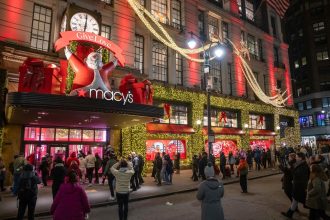If there’s anything about BYD ‘s past that could predict its future, it’s being slow and steady. The nearly 30-year-old company may have beat Tesla in total car production in 2023 , but it still only has one tenth the market value. Last year, Tesla’s shares roughly doubled in price. BYD’s rose by about 10%. Bernstein didn’t even initiate coverage of BYD until September, with an outperform rating and price target of 359 Hong Kong dollars. The upside as of Thursday’s close was 71% — far more than the 42% printed at the time of coverage initiation. Are there problems, such as oversupply, the market is overlooking? News that its famous early investor, Warren Buffett’s Berkshire Hathaway, keeps trimming its stake for unspecified reasons doesn’t help foreign investor sentiment. One factor behind the low valuation is that BYD isn’t dominating flashy markets like Norway that “would probably have a greater impact on stock price” than electrifying cars in Brazil, said Taylor Ogan, CEO of Snow Bull Capital. Another issue is lack of financial research analysts, especially covering both Tesla and China, he said. BYD trades in Hong Kong, and on the Shenzhen exchange in mainland China. The company primarily sells its passenger cars in China, with some expansion to regions such as southeast Asia and Europe, but not North America. In contrast, Nasdaq-listed Tesla’s main market is the U.S., while China accounts for about 20% of revenue. An energy company? Elon Musk’s automaker also had a hard time convincing Wall Street to buy it until the last few years . “I’m a long observer and investor in Tesla,” Ogan said. “For many, many years it was very frustrating. Broadly the excuse was, Wall Street, they don’t understand Tesla.” Ogan moved with his team of three to Shenzhen, China, in January 2023 to open a research office. BYD got its start in batteries and has a giant campus on the outskirts of Shenzhen. The company has cut costs by developing the expensive car battery in-house, while offering various vehicle models for different price segments. “What I think will tip BYD like the volumes tipped Tesla is when people start realizing BYD is an energy company,” Ogan said. “I do think there will be a day when they realize, wow, BYD makes their own photovoltaic cells, makes their own inverters, they make the battery,” he said, adding the company also makes electric buses that are “essentially roaming batteries.” He doesn’t expect the market will realize how capable BYD is until 2025. Several analysts already rate the stock a buy, although their 12-month price targets still wouldn’t bring BYD close to Tesla in terms of market value. BYD’s high-end models are selling better than expected, which can help boost margins, CLSA’s Xiao Feng said in a Jan. 2 report. That’s despite the firm’s channel checks that indicate recent price cuts helped BYD boost its December orders. “Overall, our estimate stays at 4m car sales in 2024 and we expect consensus to revise up on overly bearish profitability forecasts,” the report said. CLSA has a price target of 310 Hong Kong dollars and a buy rating on BYD. Nomura’s China autos and auto parts analyst Joel Ying likes BYD with an even higher price target of 382 Hong Kong dollars. But he also noted the stock can benefit as a battery supplier for Chinese smartphone Xiaomi ‘s electric car venture. “According to our understanding, players that are involved in Xiaomi’s EV supply chain at this moment include CATL (300750 CH)/BYD (1211 HK, for batteries), Inovance (300124 CH, for electric motors), Ningbo Tuopu (601689 CH, for chassis and air suspension etc) and Hesai Tech (HSAI US),” Ying said in a Jan. 3 report. He said Xiaomi’s SU7 will likely sell for between 200,000 yuan and 300,000 yuan ($28,160 to $42,240), similar to the Zeekr 007. That’s also the price range of BYD’s Han sedan, while Tesla’s Model Y sells in a slightly higher price bracket. — CNBC’s Michael Bloom contributed to this report.
Read the full article here





